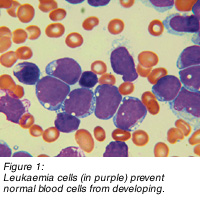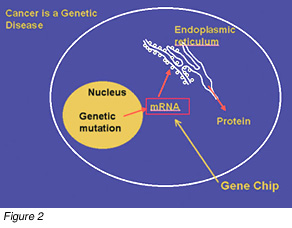|
by Tan Lay Leng

 he Singapore researchers who developed a new technique to simplify the diagnosis of childhood leukaemia win international recognition for their outstanding achievement. he Singapore researchers who developed a new technique to simplify the diagnosis of childhood leukaemia win international recognition for their outstanding achievement.
A doctor at the National University of Singapore has discovered a technique to simplify the diagnosis of leukaemia in children as well as to predict more accurately the course of treatment for better outcomes. The one-step procedure has the potential to have a big impact in the developing countries that cannot afford the expensive procedures required with current diagnostic methods.
Dr Allen Yeoh, an assistant professor at the National University Hospital (NUH), and Dr Wong Limsoon, deputy director of the Laboratories for Information Technology (formerly Kent Ridge Digital Labs), both in Singapore, have used gene-expression profiling and clever data-mining algorithms that derive information from massive amounts of raw data to improve the treatment of childhood acute lymphoblastic leukaemia (ALL).
Childhood ALL is a disease caused by genes mutating in the nucleus of leukaemia cells. These rogue genes hijack the cellular machinery, and send out messages in the form of messenger ribonucleic acids (mRNA) to the cell, telling it to divide uncontrollably. The resultant over-exuberant growth of leukaemia cells (Figure 1) prevents normal blood cells from developing. This inhibiting effect leads to a decrease in the number of normal blood cells, which in turn results in increased susceptibility to infection, anaemia (insufficient red blood cells), and easy bruising - hallmarks of leukaemia.
A diagnosis of childhood ALL, the most common form of childhood cancer worldwide, used to mean a death sentence. In the early 1970s, only one in 10 children survived the disease in Singapore. However, researchers have made dramatic progress over the last 30 years, improving the cure rates to the current 75% level. With higher recovery rates, doctors realised that it is crucial to minimise the long-term side effects of the treatment regime in childhood ALL survivors. Specifically, they need to balance the patient's risk of relapse against the toxic side effects of drugs given to treat the disease.
Clinicians have found that despite the fact that leukaemia cells look identical beneath the microscope, not every child has the same disease. Patients below one year or above ten years of age, and those with a high white blood cell count at diagnosis, have a higher risk of relapse. With improved understanding of the molecular biology of leukaemia over the last decade, the presence of specific gene fusions accurately predicts the chance of a cure.
The realisation of the value of these prognostic factors has led to risk-stratified therapy; doctors prescribe different levels of treatment, the intensity of which is dictated by prognostic factors identified in the patients at diagnosis. However, the determination of these prognostic factors requires a complex and expensive series of laboratory investigations only found in the developed countries. Moreover, these diagnostic approaches require the combined expertise of a variety of trained laboratory professionals whose skills are not readily available in most of the developing countries. Children from these countries have no access to the important treatment stratifications and may receive therapy that either increases their risk of relapse because of under-treatment or exposes them to un-necessary risk of treatment side effects.
Expression Profiling
 The genetic mutation that causes leukaemia sends out a specific but limited number of messages in the form of mRNAs that transform the cell into a leukaemia cell. Yeoh and his colleagues exploited the technique of expression profiling using microchip-array technology to eavesdrop on the messages emitted from the cell nucleus (Figure 2). This procedure involves simultaneously measuring the levels of 12,000 different mRNAs. By analysing the messages from different types of childhood ALL, the researchers were able to identify the message profiles specific to these mutations, also known as expression profiles, which define the various subgroups of leukaemia. The team could determine different subtypes of childhood ALL with an accuracy rate greater than 95%. The genetic mutation that causes leukaemia sends out a specific but limited number of messages in the form of mRNAs that transform the cell into a leukaemia cell. Yeoh and his colleagues exploited the technique of expression profiling using microchip-array technology to eavesdrop on the messages emitted from the cell nucleus (Figure 2). This procedure involves simultaneously measuring the levels of 12,000 different mRNAs. By analysing the messages from different types of childhood ALL, the researchers were able to identify the message profiles specific to these mutations, also known as expression profiles, which define the various subgroups of leukaemia. The team could determine different subtypes of childhood ALL with an accuracy rate greater than 95%.
Gene-expression profiling using the microchip-array platform is a new high-throughput methodology that profiles thousands of messages emanating from the nucleus of a cell simultaneously, not unlike the way the National Security Agency in the United States can screen all e-mails for messages that contain certain keywords associated with terrorist activity.
The scientists take gene-expression profiles obtained from the gene chips that interrogate the leukaemia mRNA and feed them into the computer. Using machine learning and data-mining artificial intelligence methods, the computer discovers and learns the mRNA profile associated with the specific type of leukaemia.
If the computer gets an unknown sample, it can compare the gene-expression profile of this unknown sample with the patterns that it has learned to recognise. It then assigns the sample to the group whose pattern it most closely resembles.
Using the mRNAs extracted from 389 diagnostic bone marrow samples, Yeoh and his colleagues at St Jude Children's Research Hospital in the US studied the feasibility of using the gene chip as a diagnostic tool. The raw expression profiles were then sent to Wong and his colleagues at the Laboratories for Information Technology for computational analysis.
The work shows that gene expression profiling is a new, exciting, and robust platform for diagnosis and disease prognostication in childhood ALL. It provides fresh insights into the biology of a leukaemia cell and can probably be extended to other cancers and human diseases that have a genetic basis.
Putting Singapore on the World's Medical Map
What are the chances that research from a small country like Singapore will win a prestigious American award in the face of world-class competition? And how about the probability of qualifying to be one of the eight papers selected from 5,400 international medical entries?
The chances are very good if the work is outstanding, as Yeoh and his colleagues have proven. The team's research on childhood ALL has won them the American Society of Hematology (ASH) Merit Award. Yeoh has also received the Dr Harry B Neustein Memorial Award given by the Society of Paediatric Pathology in the US. His paper on childhood ALL, detailing the findings to provide a better understanding of the biology and the treatment of the disease, was chosen for presentation at the ASH Meeting that was attended by more than 10,000 healthcare delegates last December.
Yeoh also received the NUS Young Investigator Award early this year in recognition of his contribution to the field of research.
For more information contact Dr Allen Yeoh at paeyej@nus.edu.sg or Dr Wong Limsoon at limsoon@krdl.org.sg.
|



 he Singapore researchers who developed a new technique to simplify the diagnosis of childhood leukaemia win international recognition for their outstanding achievement.
he Singapore researchers who developed a new technique to simplify the diagnosis of childhood leukaemia win international recognition for their outstanding achievement.
 The genetic mutation that causes leukaemia sends out a specific but limited number of messages in the form of mRNAs that transform the cell into a leukaemia cell. Yeoh and his colleagues exploited the technique of expression profiling using microchip-array technology to eavesdrop on the messages emitted from the cell nucleus (Figure 2). This procedure involves simultaneously measuring the levels of 12,000 different mRNAs. By analysing the messages from different types of childhood ALL, the researchers were able to identify the message profiles specific to these mutations, also known as expression profiles, which define the various subgroups of leukaemia. The team could determine different subtypes of childhood ALL with an accuracy rate greater than 95%.
The genetic mutation that causes leukaemia sends out a specific but limited number of messages in the form of mRNAs that transform the cell into a leukaemia cell. Yeoh and his colleagues exploited the technique of expression profiling using microchip-array technology to eavesdrop on the messages emitted from the cell nucleus (Figure 2). This procedure involves simultaneously measuring the levels of 12,000 different mRNAs. By analysing the messages from different types of childhood ALL, the researchers were able to identify the message profiles specific to these mutations, also known as expression profiles, which define the various subgroups of leukaemia. The team could determine different subtypes of childhood ALL with an accuracy rate greater than 95%.